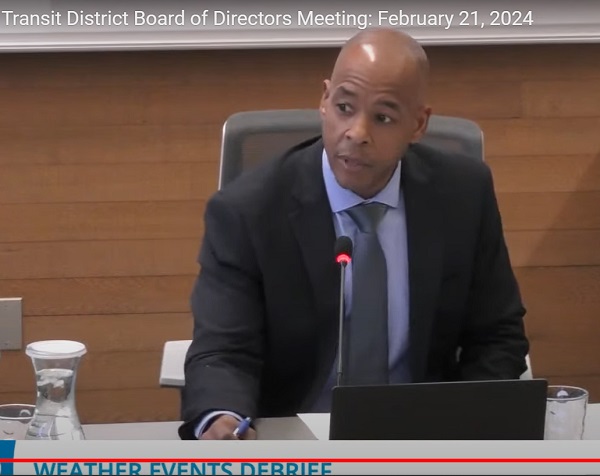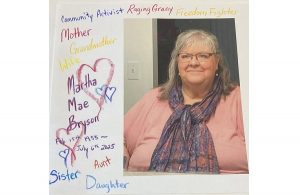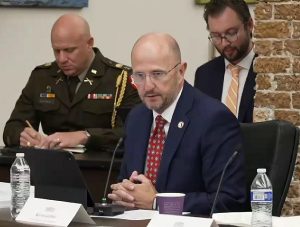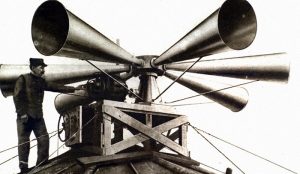LTD looks back at the ice storm: ‘We need to be more prepared’
11 min read
LTD shares lessons learned from the ice storm. At its Feb. 21 meeting, the Lane Transit District board hears from CEO Jameson Auten:
Jameson Auten (LTD CEO): Just wanted to color in in what happened during the ice storm a bit, really from the purpose of describing what we were looking at, but also: What are some next steps that can help us better serve our community?
[00:00:23] I really feel that this ice storm, while impactful to our community in all the worst ways, it can be a rehearsal for something bigger. And I think we need to be more prepared.
[00:00:34] So the decision-making process during that time was made through really three questions: (1) What can we do? You know, we were living in an ice cube, so what can we really do? (2) Is the community safe if we do it? And (3) are our employees safe if we were to do it, as well?
[00:00:50] So we had eyes on the street the entire time. I hate to give Jake, where’s Jake? He’s not in here. Hate to give Jake his props ’cause Jake and I have this little back-and-forth thing. But Jake McCallum, I got to work side by side with him throughout this process, and Jake and his team really kept—they stayed here, they kept their eyes on what was going on and along with Josh (Schmit), with public safety, really assessing what was going on in the street, but also Matt (Imlach) and his team with our facilities because you can’t get to the bus without getting to the bus stop.
[00:01:19] So that was important. So the impacts that we had that led to us shutting down from the 13th to the 18th: So we shut down the evening, Saturday, that evening, and we reopened Thursday morning on the 18th. The impacts were, you know, we were unable to help people to get where they needed to be.
[00:01:37] And if you think about our fixed route, that’s one thing, but also our RideSource service is another thing. And a lot of those trips involved dialysis and medical appointments and things like that. John Ahlen’s group did a good job coordinating with emergency services, so they were able to provide some of those trips.
[00:01:56] We did get a request from RideSource to use our supervisor vehicles. Apparently the Chevys that we have run better in the snow than the vehicles that they typically use. So wwe have some recommendations for that as well.
[00:02:10] Our employees here experience the same thing as the rest of the community. We have quite a few employees that are in Cottage Grove or in Creswell, also in Thurston. And they had the same issues. They were out of power. They couldn’t shower, they couldn’t get here. They had their families to take care of as well. So that was something that we experienced.
[00:02:31] The other fact of the matter is: Buses don’t do well on ice, okay? They just don’t, and when you talk about a 60-foot articulated bus with the back end swinging around and no one wants to see the business side of that. So we did have two accidents during that time. They weren’t major accidents, but we did have two.
[00:02:52] The bigger piece that we get is stuck buses. And no matter what time we decide to curtail service or cancel service, there’s always folks on there well after the time service stops getting those buses unstuck and back here. So we had two full-time employees out there that worked the whole shift, just doing that, getting those buses back.
[00:03:12] Estimated cost (’cause we tracked that) was about $125K over that time. I have a breakdown of what that was, if you’re interested. A lot of it was tree service and other things, physical ice removal. And when I say that we were living in an ice cube, literally, as you’ll recall, there was constant chipping away of the ice. So we brought in some outside folks.
[00:03:35] Historically, LTD has volunteers that go clean up the bus platforms. Historically we do that… No. Our risk management person, yeah, he agrees with me. We’ve got to have other people come in. We don’t want slip and falls (God forbid). We don’t want heart attacks and things like that. So this ice storm, that added up.
[00:03:57] We found out that it’s hard to charge electric buses when you’re on backup generator and the backup generator’s having issues. So we will have more of that conversation later.
[00:04:07] And then also we decided to open the facility to families that could get here if they wanted to shower or use the electric or watch TV or whatever they wanted to do. But then we got the boil notice. So that was problematic as well.
[00:04:23] What worked well? I think there’s some things that did work well. Now the operations team did a good job, very committed to community service. And when I say it was painful to cancel a service, it was the right thing to do. The employees all felt that way, so I wanted to express that.
[00:04:39] But our external communications team did a really good job. They prepped for this storm in a different way. They let the media know, they put it out on social media as well, that there may be some changes, continue to look here to see if service gets modified. So they did that well before the storm hit.
[00:04:56] Internally, we did a good job communicating as a management team on what was going on in the streets. We had a daily briefing just to be able to assess conditions and decide where we needed to go next. ATU (Amalgamated Transit Union Local 757) was doing the same thing with their members as well, and we were doing the same thing with the employees.
[00:05:14] And we were also looking at what RideSource was doing as well. So, a pretty comprehensive look to see what the conditions were, and then go back through that lens of those initial three questions on: What can we do?
[00:05:25] Decision-making went well. I think that having the eyes on the street and having those communications, we were able to make decisions a little faster. I think the team realized that it’s okay to make that decision. We developed some muscle memory there.
[00:05:41] I also think that the communications group, again, did a good job getting back to the media with timely updates on what we were going to do. So I thought that that all worked well.
[00:05:52] There are some opportunities. We always want to look at: How can we improve, how can we get better? So there are some opportunities.
[00:05:58] One is, IT is developing an alarm for when we lose power. Why is that important? ‘Cause our generator went down, the exhaust vent froze, and we lost power and we were 20 minutes away from losing our servers.
[00:06:14] So we’re going to create an alarm to know when we lose power, so we can address that right away. But we’re also going to be looking at redundancies on how we manage our servers, make sure our data is backed up, whether that’s cloud-based or remote backup server locations, I’ll leave that to Scott Sorensen to figure out. But that’s important for us to do.
[00:06:36] Some were as simple as ice cleats, ice cleats for our employees to get around. We had several slip and falls here; we had a broken nose, we had someone hit their head on the curb. So we’re going to be looking at those anti-slip devices for our employees.
[00:06:52] Facilities had them, most of the Facilities staff had them, and that’s why they were able to clear off. I watched them clear off—notice I said ‘watch,’ not ‘help,’ I had to keep moving—I watched them clear off part of a Springfield station and it was a lot of work there. We had some tired people here, but ice, those cleats will help.
[00:07:13] We talked about the vehicles for RideSource having chains or cables for those. Again, not just for RideSource to use them, but for our public safety and our road supervisors to be able to use those to get around the different locations. Those again handle much differently than our smaller cutaway RideSource vehicles and our buses.
[00:07:34] We are now looking at, and we do some, pre-treat work. I’ve confirmed that with Joe (McCormack) and Matt (Imlach) today. But we’re going to look at what some other options are and we’re talking, having some conversations with ODOT to understand what some other options are for pre-treating our surfaces.
[00:07:49] Again it was, I don’t know if there’s anything that will combat what we got hit with, but understanding what’s available to us and how we balance that off with protecting our environment is critical.
[00:08:02] And then finally a better command and control system internally. We did a good job meeting together and going through what we need to talk about to make decisions, but it has to have a really strong muscle memory. It has to be assigned. So we’re going to look at our planning and make sure that that is up to date and that we practice on that a bit more.
[00:08:25] Again, we did a good job there, but I think that if I’m out of town or Jake’s out of town or Matt’s out of town, we have to have who’s responsible for what in place and people know it. So we’re going to do that.
[00:08:36] There are some longer-term, higher-impact, higher-cost, more-planning-time things that we need to look at as well. The generator that acted up is 30 years old, so that’s about $600K to look at replacing that. But we need to look at that. So we’re going to start figuring out how we handle that.
[00:08:59] One need that was identified earlier is a way to get route schedules done quicker. So whether they’re emergency schedules that we can have standing and just kind of tweak as needed, or snow and ice schedules—we have different routes and different ways of how we’re traveling, deviations in the routes themselves. But if we have half the bus operators available, right? How do we determine which routes those are that are going to go out? So we’re working on that.
[00:09:29] A much bigger issue is we need to update our ‘Continuity Of Operations Plan’ (COOP), for various reasons. This ice storm kind of shed a light on the difficulties with charging electric buses on ice. But we’re also, if you listened to—and we heard this all last year at United Front—(Springfield) Mayor (Sean) VanGordon talked about levees and if we’re underwater. And how do you charge buses when you’re underwater, or even knee-deep in water? Who’s volunteering to do that, right?
[00:10:02] So where we’re located, if we were to have something, that big earthquake, we’re landlocked. We’re stuck right here. We can’t get vehicles anywhere else. We do have properties over on Garfield, and we probably need to look at alternative operations sites, whether we have mobile dispatching or we utilize RideSource, or we utilize, is it 310 Garfield? 410? One of the ‘10s, 310 Garfield site, which is ours as well. We need to start thinking through what that looks like.
[00:10:36] Now I talk about this with the team. We don’t have the time nor the talent to put a real effective COOP plan together. So we’re going to start having conversations. I have a meeting scheduled with the vice president of Resiliency over at U of O. We’re going to talk with him. I talk with the county administrator tomorrow afternoon. We’re going to talk with him as well. We’re going to start to put together: What do we do? How do we operate? When these events happen, these different command control centers open up, we need to have a plan on how we integrate there.
[00:11:12] If something bigger were to happen in Lane County, we’re not in charge, we’re a resource. So we need to understand how to be the best resource that we can be. So that will be: We’re going to start doing some background work on that, that will be reflected in an upcoming budget because we need to get that done and we’re going to need some outside help on that. That’s a big deal. That’s a big deal for us and for the community.
[00:11:34] So those are the things that we’ve learned through this process. Again, a lot of good work was done, but I think that in terms of long term for the organization, for the region, we’ve got to get that Continuity Of Operations Plan (COOP) squared away and we have to know where we’re going to be operating if something major were going to happen.
[00:11:53] Pete Knox (LTD board): Thank you, Jameson. That was very comprehensive. and I actually just want to say, number one, I think you guys did an amazing job dealing with this storm. We seem to getting more of these, unfortunately, as our climate is changing.
[00:12:09] And I saw a wonderful picture of a bus absolutely encased in ice on Facebook, and, pretty sure that bus wasn’t going anywhere.
[00:12:18] The question I have for you, I will tell you that, I personally just kind of sheltered in place, but all my friends who tried even to get outside slipped and fell. Most, luckily, none of ’em really hurt themselves. If you’re in a situation where people have the potential of harming themselves to just to get to work, is that a liability for us as an organization?
[00:12:45] Jameson Auten (LTD CEO): I think it’s indicative of what’s going on throughout the entire system. At some point, there is liability for us, right? So if you, one thing that we noticed was our stations, those were all encased in ice. And even if we can clear our stations, our stops. So our stops for EmX couldn’t get close enough to the platforms, we would’ve been boarding people in the street.
[00:13:09] So yeah, from that standpoint, there could have been some liability for us if we would’ve operated that way. However, the path of travel to get to the station or to stop matters. Now that’s not in our control, for the most part. But if it’s that bad, and the operating conditions are as they were, then certainly there would’ve been some unsafe things that we would’ve been doing in the operation.
[00:13:34] Gino Grimaldi (LTD board): Regarding the homeless, which is a community problem, it’s obvious you’re having conversations with community members. Is it a topic of conversation about what to do to make sure that those who have no transportation and no housing are able to get to a place where they can stay warm and potentially stay alive?
[00:13:56] Jameson Auten (LTD CEO): Yeah. It’s an absolute conversation. I think, Gino, that was the hardest part of stopping service, that, when we’re operating on ice, we’re in the same, we’re rendered in the same position as everyone else, and we just can’t get there. And we would’ve been doing more harm to the community if we did operate.
[00:14:15] Gino Grimaldi (LTD board): Okay. Thank you. Lot of good work there. Thank you.
[00:14:19] Jameson Auten (LTD CEO): I thank the staff. Thank you.
[00:14:21] John Q: After the ice storm event, LTD looks at ice cleats for employees, a new backup generator, and a Continuity of Operations Plan.





